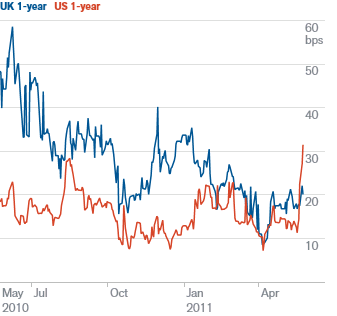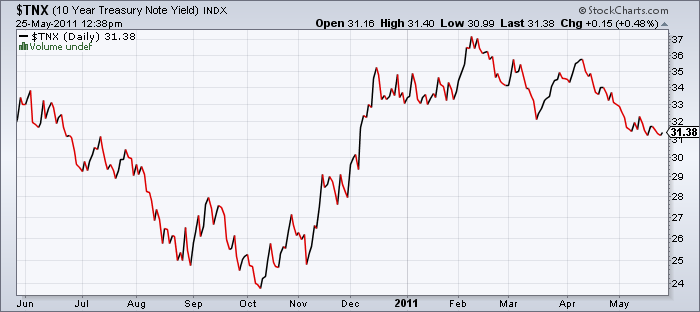by Cullen Roche
We’re seeing one of those odd occurrences again where USA CDS are surging higher and bond yields are moving lower (thanks to Joe Weisenthal for pointing this out). Earlier this year I discussed the exact opposite phenomenon. What we were experiencing was a period of marginally higher inflation due to stronger economic growth and a flat line in USA CDS. At the time, many were talking about the stirring “bond vigilantes” and how they were about to bring their doom and gloom down upon the US economy. Of course, that didn’t happen and neither did the hyperinflation.
Today, it’s the US debt ceiling and our impending default that has investors worried for no reason other than their own lack of knowledge with regards to the real workings of a modern fiat monetary system. Interestingly, we’re seeing the exact opposite price action from earlier this year. USA 5 year CDS (priced in Euros) are rising and bond yields are falling. Markit provided a snapshot of the situation:
“The US, however, has seen its one-year spreads widen significantly in recent days and move well above the UK’s. The long-term fiscal challenges that the US faces are well-known but these are irrelevant for the short-end of the curve. Recent activity data from the DTCC shows that the number of trades referencing the US has gone up dramatically and was five times that of the UK last week. It appears to have been triggered by concerns over the US debt ceiling and the possibility of technical default. This seems far-fetched to European observers but is the subject of intense political debate in the US.”

But the 10 year US Treasury continues to decline. What in the world is going on here? Why aren’t yields pricing in default risk like the CDS market is? Well, it’s just another real-time view of the inefficient market at work.

The CDS market is concerned that there is some risk of a US technical insolvency so we see hedgers bidding up prices. The bond market, however, sees no risk of default. They see only lower inflation. Now, this is an obvious flaw in market dynamics for anyone who understands how our monetary system works. After all, there is no such thing as the USA being able to turn into Greece. There is no such thing as the USA being able to “run out” of the currency that only it can produce. It cannot become insolvent in the same manner that Greece can. As a sovereign monopoly supplier of currency in a floating exchange rate system with no foreign denominated debt it is entirely impossible for the USA to become insolvent in the traditional manner of not being able to make payments in the currency that only it can print (boy, that was a mouthful!).
The only form of insolvency that the US government could suffer would come in the form of hyperinflation. Regular readers are familiar with my research on this and know that I have believe hyperinflation has been a non-issue for many years now and still believe this today. So, if the USA was becoming insolvent yields should be surging as bond investors flee US Treasuries. Clearly, that’s not occurring. So, there’s a clear market inefficiency at work here. One of these markets is 100% wrong. And if you understand the workings of the modern monetary system it should be abundantly clear to you which market that is….
No comments:
Post a Comment